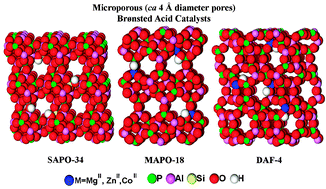The several factors that render certain kinds of nanoporous oxidic solids valuable for the design of a wide range of new heterogeneous catalysts are outlined and exemplified. These factors include: (i), their relative ease of preparation, when both mesoporous siliceous frameworks (ca. 20 to 250 Å diameter pores) and microporous framework-substituted aluminophosphates (ca. 4 to 14 Å diameter pores) can be tailored to suit particular catalytic needs according to whether regiospecific or enantio- or shape-selective conversions are the goal; (ii), the enormous internal (three-dimensional) areas that these nanoporous solids possess (typically 103 m2 g−1) and the consequential ease of access of reactants through the internal pores of the solids; (iii), the ability, by judicious solid-state preparative methods to assemble spatially isolated, single-site active centres at the internal surfaces of these open-structure solids, thereby making the heterogeneous catalyst simulate the characteristic features of homogenous and enzymatic catalysts; (iv), the wide variety of in situ, time-resolved and ex situ experimental techniques, coupled with computational methods, that can pin-point the precise structure of the active site under operating conditions and facilitate the formulation of reaction intermediates and mechanisms. Varieties of catalysts are described for the synthesis (often under environmentally benign and solvent-free conditions) of a wide range of organic materials including commodity chemicals (such as adipic and terephthalic acid), fine and pharmaceutical chemicals (e.g.vitamin B3), alkenes, epoxides, and for the photocatalytic preferential destruction of carbon monoxide in the presence of hydrogen. Nanoporous oxidic solids are ideal materials to investigate the phenomenology of catalysis because, in many of them, little distinction exists between a model and a real catalyst.


 Please wait while we load your content...
Please wait while we load your content...